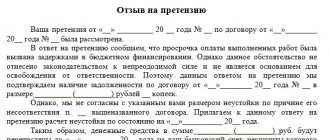Ready integrations with business services
Under the loan agreement in accordance with clause 1 of Art. 807 of the Civil Code of the Russian Federation, one party (the lender) transfers into the ownership of the other party (borrower) money or other things determined by generic characteristics, and the borrower undertakes to return to the lender the same amount of money (loan amount) or an equal number of other things received by him of the same kind and quality .
The borrower’s obligation may be terminated as a result of concluding a debt forgiveness agreement, according to which the creditor releases the debtor from his obligations, including repayment of the loan amount, if this does not violate the rights of other persons in relation to the creditor’s property (Article 407, 415 of the Civil Code of the Russian Federation).
The organization is engaged in trading activities, as well as production, outsourcing materials for processing. Finished products and goods on hangers are packaged in plastic bags and boxes and in this form are sent to customers and commission agents.
Tax Code of the Russian Federation) income will be taken into account, the debtor organization as a result of debt forgiveness for profit tax purposes arises non-operating income. Cases of debt forgiveness of a parent or subsidiary company occur quite often in financial and economic activities.
https://youtu.be/L—JPYNDVIU
Sample debt forgiveness agreement
—————————————————————————¬ ¦ Agreement ¦ ¦ on debt forgiveness ¦ ¦ ¦ ¦r. Samara October 1, 2013¦ ¦ ¦ ¦ 1. According to the loan agreement dated 05.08.2013 N 54 I.P. Kazakov had to fulfill obligations to repay the loan in the amount of 350,000 rubles. until October 1, 2013. On time I.P. Kazakov fulfilled his obligations only in terms of repaying the debt in the amount of 50,000 rubles. ¦ ¦ 2. Based on Art. 415 of the Civil Code of the Russian Federation, LLC “Uspeh”¦ ¦ releases I.P. Kazakov from his obligations specified in clause 1 of this Agreement, regarding payment of a loan in the amount of 300,000 (Three hundred thousand) rubles. ¦ ¦ ¦ ¦General Director of LLC “Success” Founder of LLC “Success” ¦ ¦ Ivanov A.P. Ivanov Kazakov I.P. Kazakov¦ ¦ Print ¦ ¦ LLC “Success” ¦ ¦ M.P. ¦ L—————————————————————————
Figure Question No. 2. How to forgive a debt through offset of mutual debt?
The founder can repay his debt to the company in other ways, for example, by offsetting mutual claims, if the company also has a debt to him. So, when a company has a net profit, it pays dividends to participants. Let us remind you that net profit can be distributed not only at the end of the year, but also based on the results of a quarter, half a year or 9 months, if such a procedure is prescribed in the constituent documents (clause 1, article 42 of the Federal Law of December 26, 1995 N 208-FZ and clause 1 Article 28 of the Federal Law of 02/08/1998 N 14-FZ).
Essence of the question. The founder can repay his debt to the company with dividends that are accrued to him but not paid.
An obligation may be terminated in whole or in part by offsetting a counterclaim of a similar nature, the due date of which has come or the due date of which has not been specified or is determined by the moment of demand (Article 410 of the Civil Code of the Russian Federation). The current legislation does not establish any prohibition on offsetting obligations to pay dividends against a counterclaim for loan repayment (Article 411 of the Civil Code of the Russian Federation). This means that the founder can pay off his debt to the company in this way. To formalize the offset of mutual claims between the company and the founder, an act is drawn up in any form. The day on which the act is signed is considered the day of offset.
Debt forgiveness between legal entities tax consequences
Forgiveness is not a separate transaction; it is the termination of the obligation under the original compensation agreement. Therefore, such debt write-off can be issued by the creditor unilaterally without any limitation on the amount.
At the same time, when a debt is forgiven, the debtor’s (buyer’s) obligation to the creditor (supplier) from his obligations ceases, unless this violates the rights of other persons in relation to the creditor’s property.
The seller calculates VAT from the cost of the property at the time of its shipment, and the forgiveness does not affect the VAT base in any way. Accounting. On the date of sale of the goods, the seller makes accounting entries to recognize revenue and write off the cost of the goods. The debt is recognized as another expense on the date of forgiveness.
Sviridova Tatyana Your organization is owed by another organization//Accounts receivable// If the creditor releases the debtor from his obligations, then there is forgiveness of the debt, which is permissible provided that this does not violate the rights of other persons in relation to the creditor’s property (Art. 415 of the Civil Code of the Russian Federation).
Liquidation balance sheet: how to reset indicators
Since, as a result of concluding a debt forgiveness agreement with the lender, the borrower who previously received funds under the loan agreement ceases to have the obligation to repay the debt, such funds are received free of charge.
The operation to terminate debt obligations represents the annulment of the debtor’s obligation to the creditor. Such actions are only possible if they do not violate the rights of third parties. Let's consider two examples - debt to pay for goods and debt under a loan agreement without interest with examples of postings, taxes and postings, as well as accounting for simplification. Using these examples, we will analyze the procedure for reflecting debt forgiveness transactions in tax and accounting.
The main taxes that legal entities are required to pay include value added tax and income tax.
Entries for accounting for interest on a loan
The party receiving the loan accrues interest on it monthly, unless a different frequency of accrual is provided for in the agreement, recording this by posting:
Dt 91 Kt 66 (67).
The fact of payment of interest will be displayed as:
Dt 66 (67) Kt 51.
The party that issued the loan will accrue interest at the same frequency as the borrower, and will take this into account by posting:
Dt 76 Kt 91.
She will reflect the receipt of interest as:
Dt 51 Kt 76.
Read about the main points that determine the differences between a loan and a loan in the material “Accounting for loans and borrowings in accounting .
Formation of tax and accounting reports
Yes, the Landlord Organization can forgive part of the debt to the Tenant due to a difficult financial situation.
He also has the status of an individual entrepreneur and applies the simplified taxation system with the object of taxation “income minus expenses.” An individual lent money at interest to companies in which he is a participant. Loans were issued both during the period when the citizen was a member of the companies, and during the period when he was not yet a member of the companies.
Taxpayers using the simplified system determine income from the sale of goods, works, services and property rights in the manner established by Art. 249 of the Tax Code of the Russian Federation, and non-operating income - in the manner established by Art. 250 Tax Code of the Russian Federation. 1 tbsp. 346.15 Tax Code of the Russian Federation.
Individual entrepreneur “husband” - simplified tax system (6%), individual entrepreneur “wife” - simplified tax system (6%). Individual entrepreneur “husband”, at the expense of income from his business activities, on which he has paid tax, issues an interest-bearing loan to individual entrepreneur “wife” for the development of entrepreneurial activity. There are no payments under the loan agreement. After a year, the individual entrepreneur “husband” forgives the debt of the individual entrepreneur “wife”.
And income in the form of interest on the loan is taken into account on the date of forgiveness, since on this date the debtor’s debt to pay interest ceases. The amount of the forgiven debt is not recognized as part of the expenses taken into account when determining the tax base under the simplified procedure.
Thus, debt forgiveness is a unilateral legal action, that is, it does not require the conclusion of any agreement between the parties. It can be issued in the form of a decision of the authorized body of the creditor, a notice, or any other unilateral document (for example, a message).
The income in question should be taken into account for the purpose of calculating tax when applying the simplified tax system on the date of debt forgiveness.
A blog is your new tool to talk about yourself. Publish any content about your company.
Forgiveness of a debt from an individual entrepreneur should be considered as revenue from the sale of services. The income in question should be taken into account for the purpose of calculating tax when applying the simplified tax system on the date of debt forgiveness.
Can a legal entity enter into voluntary liquidation without distribution of net profits or forgiveness of debt? How high is the risk of a tax audit after filing an application for voluntary liquidation?
Loan repayment to the founder and debt forgiveness in 1C: Enterprise Accounting 8
21.07.2018 12:10 6399
In one of the previous articles, we looked at options for helping a founder in an unfavorable financial situation in a company (Receiving a loan from an individual founder and reflecting it in 1C: Enterprise Accounting 8.) Today I would like to tell you about possible options for repaying a loan received from the founder .
In this article, we do not consider in detail the intuitive accounting entries for the standard repayment of a cash loan (Dt 66.03, 66.04 - Kt 50, 51).
Let us dwell on the nuances of the loan repayment procedure:
– cash proceeds cannot be spent on loan repayment; it must be deposited into a current account and then the repayment amount must be transferred by bank transfer;
– the date of return of funds specified in the contract will insure the company against ambiguous interpretation of the validity period of the contract. In other words, after 3 years the company will not have an unjustified tax benefit in the form of written off accounts payable not included in income;
– the amount of the repaid loan from the borrower is not an expense taken into account for profit tax purposes;
- when repaying a loan in cash, the borrower does not have VAT obligations (the transaction is exempt from VAT).
In addition to repaying the loan, there is another option - the founder can forgive the organization’s debt. This can be either the amount of the principal debt or the amount of interest accrued under the loan agreement.
Let's consider how this is reflected in the accounting and tax accounting of an organization on OSNO.
When a debt is forgiven, a corresponding agreement (in writing) is concluded between the organization and the founder.
Debt forgiveness in this case is recognized as a gratuitous transfer of property and is included in non-operating income.
Reflection by the borrower organization of the loan amount forgiven by the founder (the founder’s share in the company’s capital is 50% or less):
To check, we create Analysis of account 66.03.
But if the founder’s share of participation is over 50%, then such a transaction is not included in the organization’s income. In this case, debt forgiveness can be formalized as an increase in the organization’s net assets. Let us recall that the company's net assets are the company's own funds, which will remain after it pays off its creditors. In other words, the company's equity capital.
Important: If the net assets are less than the authorized capital, the company may face forced liquidation. An increase in the organization's net assets does not affect the amount of the authorized capital.
Let's consider the reflection of the operation of increasing the company's net assets in 1C: Enterprise Accounting 8 edition 3.0 (reflection as of the date of the founder's decision).
To check, we will create an Analysis of account 66.03 (loan closed).
And also Analysis of account 75.01 “Calculations for contributions to the authorized (share) capital.”
The “Capital and Reserves” breakdown of the balance sheet reflects the amount of additional capital in account 83.09 “Additional capital. Other sources."
The amount of interest forgiven under the loan agreement is, in any case, regardless of the share of participation of the founder, non-operating income of the organization.
Reason: The amount of forgiven interest on the loan cannot be considered as property received free of charge (clause 11, clause 1, article 251 of the Tax Code of the Russian Federation). Forgiven interest is taken into account in income as accounts payable written off for other reasons.
Important: Postings are made on the date of signing the debt forgiveness agreement.
Reflection by the borrower organization of the amount of accrued interest forgiven by the founder:
We form an analysis of account 66.04.
For an organization that uses the simplified tax system, when a debt under a loan agreement is forgiven, neither the amount of the principal debt (if the founder’s share of participation is more than 50%) nor the interest accrued under the loan agreement is included in taxable income.
Reason: Under the simplified tax system, income includes income from the sale of goods (work, services) and property rights and non-operating income. In addition, under the simplified tax system, income is determined by the cash method (Letter of the Ministry of Finance of the Russian Federation dated May 31, 2016 No. 03-11-06/2/31354).
Important: Risks under the simplified tax system arise when an agreement on debt forgiveness is not concluded. Upon expiration of the limitation period, such accounts payable must be written off as income (non-operating income of the organization).
Risks under the simplified tax system also arise if it is not a monetary loan, but a property loan, that is forgiven. In this case, the property should not be sold to third parties during the year.
And finally, advice for companies using any of the taxation systems under consideration.
If a company has two founders, it is advisable that the shares are not distributed in the ratio: 50% + 50%. This situation confuses the very possibility of providing financial or property assistance without inclusion in non-operating income. Option: 49%+51% differs slightly, but already allows the company not to take into account the founder’s loan (50% or more) in the tax base.
Irina Kazmirchuk
Source: https://xn--80abbnbma2d3ahb2c.xn--p1ai/bukhgalteriya-3-0/main/bukhgalteriya-3-0/vozvrat-zaima-uchrediteliu-i-proshchenie-dolga-v-1s-bukhgalterii-predpriiatiia- 8
How to formalize and reflect debt forgiveness to a counterparty
The income will have to be reflected, because... Simplified income recognizes not only the receipt of payment, but also the repayment of an obligation by debt forgiveness. Otherwise, there is a risk of additional taxes. If the same conditions are met, the amount of forgiven interest that was included in income can be taken into account as expenses. But on the simplified tax system, it will not be possible to take into account the amount of forgiven debt for loan repayment or interest payment in expenses in any case, since the list of expenses under the “simplified system” is closed and does not provide for such expenses (Art.
One legal entity may forgive a debt to another legal entity in the following cases:
- due to the inability of the debtor to repay the loan received (regulated by Article 416 of the Civil Code of the Russian Federation);
- in connection with the termination of the activities of a legal entity acting as a borrower, that is, the liquidation of a legal entity (regulated by Article 419 of the Civil Code of the Russian Federation);
- in connection with the adoption of any act by one of the state bodies, as a result of which payment of debt becomes impossible (regulated by Article 417 of the Civil Code of the Russian Federation).
After both parties sign an agreement canceling the debt, entries are made in the creditor’s accounting to write off the debt as expenses. In tax accounting, you need to focus on the applicable tax regime.
Accounting for forgiven debt of an individual entrepreneur using the simplified tax system
In conclusion, we note that the amount of “forgiven” debt, a creditor organization that applies the simplified tax system with the object of taxation “income minus expenses,” does not have the right to include in expenses, since the write-off of these amounts is not provided for in the closed list of expenses listed in paragraph 1 of Art. 346.16 of the Tax Code of the Russian Federation (letters of the Ministry of Finance of Russia dated October 23, 2009 N 03-11-06/2/222, dated August 21, 2009 N 03-03-06/1/541).
To get an answer to your question, write it in the “Accountant Consultation” section.
Well, since it turns out that as a result of debt forgiveness, the debtor’s obligation is considered terminated, that is, repaid, then the creditor receives taxable income on the simplified tax system in the form of the amount of the forgiven debt. Example. The company shipped goods worth RUB 500,000 to the buyer using the simplified tax system.
There are no restrictions on the size of the share in the authorized capital or the organizational and legal form of the founder, an individual or legal entity. The transferred amount is also not limited by law.
The material was prepared on the basis of individual written consultation provided as part of the Legal Consulting service.
The service generates a personal tax calendar for you. Takes into account the form of ownership, the presence of employees and the taxation system.
The creditor's silence, inaction, or failure to present demands for the provision of what is due cannot be considered debt forgiveness. When a creditor applies the simplified tax system, the amount of forgiven debt is not taken into account in expenses, regardless of the grounds for the debt and the reasons for forgiveness. This type of expense is not included in the closed list of expenses taken into account when calculating the single tax. When the debtor applies the simplified tax system, the amount of forgiven accounts payable is taken into account in the general manner as part of non-operating income.
Agreement on debt forgiveness for a legal entity
No. 03-03-06/1/147). In a letter from the Ministry of Finance of Russia dated March 18, 2011. No. 03-03-06/1/147, financial department specialists indicated that the amount of the forgiven debt under no circumstances meets the criteria of economic feasibility and focus on generating income. Clause 2, clause 2, Article 265 of the Tax Code of the Russian Federation cannot be applied to it, since this norm refers to bad debts, and a forgiven debt, by virtue of clause 2 of Article 266 of the Tax Code of the Russian Federation, is not such. Since voluntary debt forgiveness is a gratuitous transfer of property, therefore, on the basis of paragraph 16 of Article 270 of the Tax Code of the Russian Federation, such a debt cannot be taken into account in tax expenses (letter of the Ministry of Finance of Russia dated July 12, 2006 No. 03-03-04/1/579 ).
Meanwhile, a similar approach to debt forgiveness was adopted by the Presidium of the Supreme Arbitration Court of the Russian Federation in a resolution dated July 15, 2010. No. 2833/10 (hereinafter referred to as resolution No. 2833/10) was declared erroneous. The court indicated that the list of non-operating expenses and taxpayer losses equated to such expenses is not exhaustive. This allows the taxpayer to take into account as expenses that reduce the tax base for income tax, including losses associated with debt forgiveness.
At the same time, a reservation was made about the binding nature of the interpretation of legal norms given in the resolution when lower arbitration courts consider similar cases.
However, tax authorities are inclined to argue that the position of the Supreme Arbitration Court of the Russian Federation, which is beneficial to taxpayers, applies only to those cases where the parties have entered into not just an agreement on debt forgiveness, but a settlement agreement.
Resolution No. 2833/10 was adopted in a case in which the creditor forgave part of the debt to the debtor by concluding a settlement agreement, so there is a risk that the tax authorities will consider this resolution to apply only to similar cases. When forgiving a debt, for example, by concluding a civil agreement, tax authorities will use previously adopted clarifications of the Russian Ministry of Finance.
Federal Tax Service of Russia in letters dated August 12, 2011. No. SA-4-7/13193 and dated December 22, 2010. No. ШС-37-3/18261 indicated that if an organization can prove that debt forgiveness is aimed at generating income (the presence of a commercial interest), it has the right to take into account the amount of the forgiven debt when calculating income tax. In this case, commercial interest, for example, can be expressed in reaching a settlement agreement aimed at resolving the mutual claims of the parties. In this case, the expenses incurred by the organization will comply with the requirements of clause 1 of Article 252 of the Tax Code of the Russian Federation. Since the list of non-operating expenses (including losses equated to non-operating expenses) is not closed, the company has the right to take into account the amount of forgiven debt. If there are no attempts on the part of the organization to collect the debt, it could be written off at the moment the statute of limitations expires in accordance with paragraph 2 of paragraph 2 of Article 265 of the Tax Code of the Russian Federation. The Tax Department refers to the position of the Presidium of the Supreme Arbitration Court of the Russian Federation, given in the resolution dated July 15, 2010. No. 2833/10.
However, the risk of claims for such expenses still remains, since it is unknown what explanations tax inspectors will use when conducting audits.
Tatyana Vladimirovna Sviridova General Director of the Audit Office Auditor Certified Tax and Duty Consultant Forensic Expert
Dear HotDolg visitors! To avoid risks, before making any decisions using the information posted on the site, you must seek advice or other necessary assistance (legal, managerial, psychological) for your specific situation from a specialist. If you want to get a lawyer’s opinion on your problem or if you want to receive other legal assistance (drawing up a document, representing interests in court, etc.), then use the “Sign up for a consultation” service in the upper right part of the site. Please note that it is not possible to provide answers to questions asked by visitors in the comments to the materials of the HotDolg project (especially promptly), due to their large number.
firstprev.2 of 13nextlast
Access for employees by role
The statute of limitations for repayment of the loan expires this year. What will taxation look like for the debtor and the creditor? Letter from the Ministry of Finance of Russia from Such funds, the principal amount of the loan is recognized as non-operating income on the basis of paragraph.
Can a founder give an interest-free loan to his organization in a year Views: We answer questions on the topic The minimum authorized capital for registering an LLC is only 10 rubles. This amount is only enough to organize an intermediary business within the walls of your own apartment. Let's consider in detail an interest-free loan from the founder: the tax consequences of the year.
Civil Code of the Russian Federation). You can formalize forgiveness by agreement or notice of debt forgiveness. In this case, let the Lessor send the debtor-Tenant a notice of debt forgiveness.
The Tenant organization is in a difficult financial situation. Has a large debt (200,0000 rubles) to the Lessor. The tenant requested forgiveness of part of the debt in the amount of 200,000 rubles in 2020 and part in the amount of 300,000 rubles in 2020. The Tenant and the Lessor are on the Simplified Taxation System, income reduced by the amount of expenses. Question.
Debt forgiveness with sleep income minus expenses
By virtue of Art. 415 of the Civil Code of the Russian Federation, when a debt is forgiven, the debtor’s obligation to the creditor terminates. Consequently, on the date the contractor forgives the debt, the customer’s obligation to pay for the work in the relevant part terminates. It turns out that there is no reason for not including the amount of forgiven debt in expenses.
In addition, an organization may have an obligation to calculate and withhold personal income tax when a debt is forgiven to a citizen and to charge insurance premiums when a debt is forgiven to an employee. The Department of Tax and Customs Tariff Policy reviewed the letter on the issue of applying the simplified taxation system and, based on the information contained in the letter, reports the following.
Debt forgiveness under the simplified tax system: a “profitable” revolution (Ermakova G.)
The creditor has the right to release the debtor from his obligations. This operation is called debt forgiveness. When can a debt be forgiven Debt forgiveness presupposes a clear expression of the will of the creditor to release the debtor from the obligation to repay the debt. In practice, this may be a notice or an agreement on debt forgiveness. At the same time, indicate in it what kind of debt is forgiven, its size, as well as details of the documents on the basis of which the debt arose. Read more Income tax If an organization forgives a debtor a debt, such a transaction is considered a donation Art. This is true both in the case of forgiveness of a debt for property shipped to the buyer, and in the case of forgiveness of a debt on a loan provided, and is explained as follows. In the first case, the object of VAT taxation arises on the date of shipment of sub. Read more Simplified tax system Organizations that pay a single tax on income do not have the right to include expenses in the tax base, including the amount of forgiven debt. Do not include the amount of unpaid interest on a forgiven debt in income due to paragraph 1 of the article
Can a management company, working under the simplified tax system, create representative offices? Question Organization The tenant is in a difficult financial situation.
.







